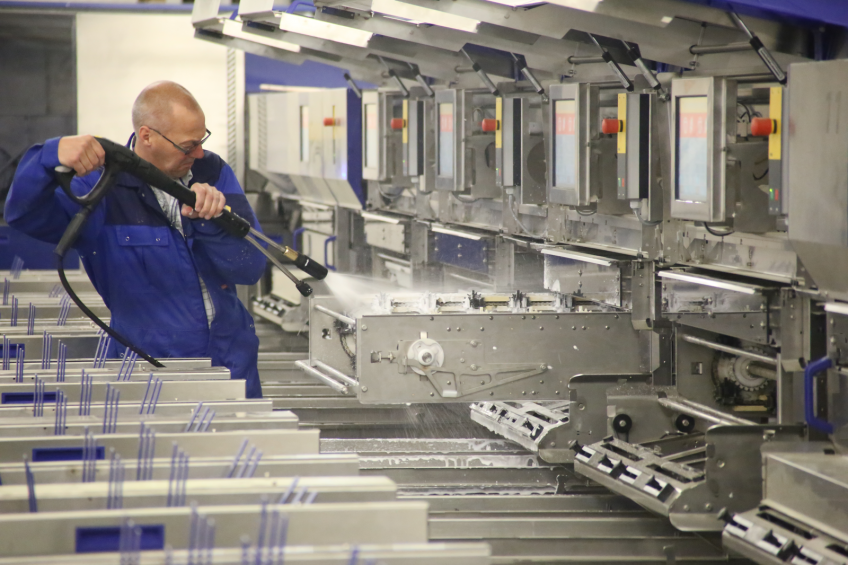Hygiene in the packing station

Food safety is becoming increasingly important in the food industry. As a result, the quality of products like table eggs must be indisputable. A high level of hygiene and access to information in the new Moba Omnia PX seems to be a major step in this direction.
By Ad Bal
An egg packing station plays a central, pivotal role in the distribution chain from farm to consumer. Here, table eggs from many sources are brought together and are graded and packed on the same, usually high capacity machine. Logically such a machine forms a risk of becoming a brooding place for germs which can easily be transmitted from egg to egg. This is contradictory to a growing global demand for safe food. As a result, the cleanliness of grading and packing is increasingly becoming important.
For this reason, Moba further improved and renewed their flagship machine Omnia. Now called Omnia PX, this machine is characterised as much more hygienic, but also easier to operate. “In the previous model of the Omnia, the FT, we had improved the hygiene of the infeed section already”, says product manager Paul Buisman of Moba. “However, once in the machine, the eggs can potentially transmit contamination such as Salmonella to other eggs. For this reason we have now done everything to make the machine as hygienic and easy to clean as possible, from the infeed section up to the very end, the packing lines. That starts with the design and construction of the machine itself and the materials we have used, but also with the ease of cleaning.”
Smart construction
One example is the material of which the packer parts are made. This is an industrial plastic, added with a mixture containing silver-ions. This so-called ‘nanotechnology’ brings anti-microbial properties into the plastic and kills harmful bacteria, like Salmonella once they get in contact with this material. The same material is used for the packer parts. As it is not a kind of film which covers these parts, but mixed throughout the material, it stays active all the time. Also UV light bars in various places in the machine, tackle bacterial load.
On top of that, very precise laser cutting allows connecting metal parts to each other, with hardly any space in between. As a result, minimal welding is needed and this prevents rough places where bacteria can easily build up. And logically, this also allows easier cleaning of such ‘hidden corners’.
All the plating (covers) now remain attached to the machine, creating less damage when opening them. And a very simple but smart solution to handle a broken egg from the packer line, is the design of the cleaning packer bins. Unlike before, these now have a bottom with holes. And a compostable bag inside the bin is collecting the broken eggs. After removal of the bag, the bin can easily be cleaned and the rinsing water can float away through the holes, without the need of taking the bins to a separate washing room. This is one of the design changes to save on cleaning efforts.
Cleaning in place
Indeed high pressure washing is the most visible characteristic of the Omnia PX. The cleaning procedure starts with activating the automatic routines for the roller section and transport grippers of the machine. After starting, ‘cleaning in place’ (CIP) inside the machine starts by adding foam, rinsing and brushing the non-removable parts such as the carrier. Used foam and water from the upper parts of the machine comes down and is thus pre-soaking the transfer line. In the meantime, sensitive parts like printers and labellers are also taken from the machine. Empty packs are taken from the denester and dust is moved from that area with an airgun.
The next step is taking out all the removable parts from the machine. For example the buffer sets are in a drawer for easy removal. Also the receiver sets are placed in a cassette and can easily be taken out. All these parts are placed in a trolley which is moved into a large kind of industrial dishwasher, called “partswasher”. There, cleaning and disinfection of all these parts is done automatically.
High pressure cleaning
While the partswasher is active, downwash of the machine by rinsing all the accessible parts takes place through high pressure cleaning. This is a manual task. Pressure of up to 120 bar is possible. Logically, targeting sensitive places such as screens and electric connections, should be avoided.
For this reason, the Omnia PX lacks buttons and controls on the lanes and all electronics are placed far above the lanes outside the splash zone. After this stage is finished, the weighing system is cleaned automatically and the packer chains are oiled one by one by an automatic dispenser. Thus the chains are kept in operational condition. Various tasks can be done concurrently by the packing station staff, making the entire process an easy and routine job. After the entire cleaning procedure has ended, all the removable parts are put in place again and the machine is ready to be used again.
Digital touchscreen
Although hygiene is a very important aspect of the Omnia PX, another important feature is the ease of operation. For this purpose, the machine is equipped with new, user friendly digital dual touchscreens above the packer lines. In the previous models, all information was only available in one central computer, making the availability of information limited and operation more sensitive to errors. The individual screens enables to have all information immediately on hand. Preciseness of the unlocking of the eggs from the receiver sets has also been improved through an innovative mechatronic solution. In combination with one extra buffer set, eggs are more efficiently distributed over the packing lanes. This system results in 2% more grade A eggs, according to Moba. That’s where at the end of the day it all comes to: providing consumers with good quality and safe eggs. It looks like the Omnia PX is another major step in achieving that goal.
New standard
The first customer of the new Omnia PX is Roel van Zetten in Ommeren, the Netherlands. Van Zetten and his father and grandfather have been using Moba machines since the late forties already. Ever since, they have been early adapters to new technology, as they very well understood the necessity of using good quality machines to guarantee high quality graded and packed eggs. And economically feasible of course.
Since March last year the PX 530 with a capacity of 190,000 eggs/hour, is in operation in their packing station. “Our staff are very positive about the ease of use and access to information through the new touchscreen”, says Roel van Zetten. “That’s daily practice which we are permanently faced with. After all, we have many different customers, egg sizes, boxes, suppliers, and so on. Traceability is key in our type of business. A customer must have access all the time to the source where his eggs originate from. Also setting up consumer packs carrying the correct information is vital for our customers. We cannot afford errors. In this respect, the new touchscreen of the PX is a very good feature. It enables us to provide all necessary details to operators exactly when and where they need it.
Coincidently, recently we were audited according to IFS regulations (International Food Standard). Our score was close to 99% which of course is very satisfying. To a certain extent, this is also thanks to the data processing on the grader and packer. But not just that, also the hygiene part of this machine is a major improvement. In our country, we don’t wash eggs, but create a high hygiene level at the source instead. And keeping the machine as clean as possible is vital in this strategy. With the new machine, we now have access to places we could never reach in the previous models. Thus, we can increase our hygienic standards without spending more man-hours. For us the Omnia PX with its features is the new standard in egg packing and grading.”
[Source: World Poultry magazine Vol 30 nr 5, 2014]













